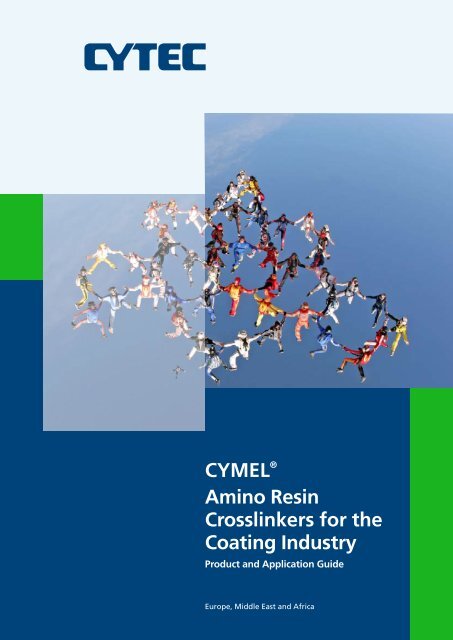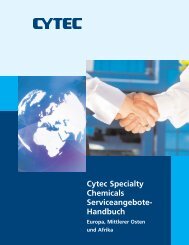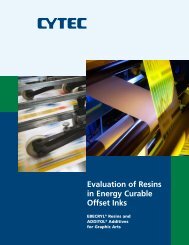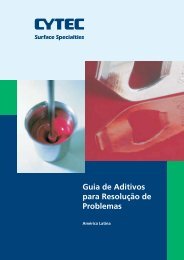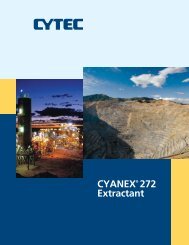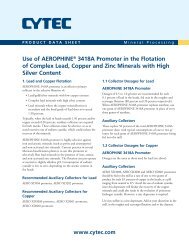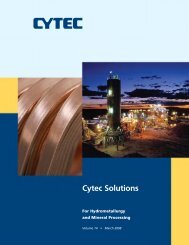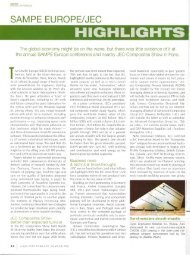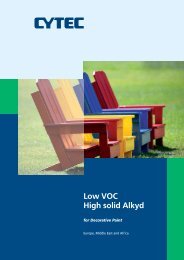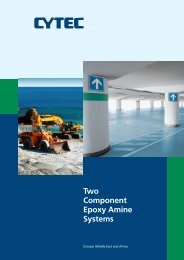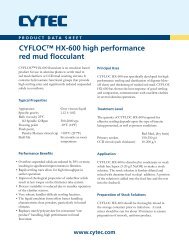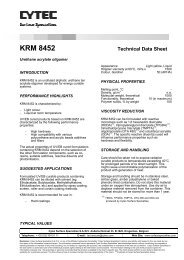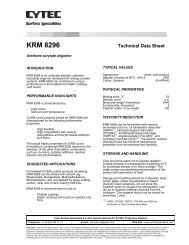CYMEL® Amino Resin Crosslinkers for the Coating Industry - Allnex
CYMEL® Amino Resin Crosslinkers for the Coating Industry - Allnex
CYMEL® Amino Resin Crosslinkers for the Coating Industry - Allnex
Create successful ePaper yourself
Turn your PDF publications into a flip-book with our unique Google optimized e-Paper software.
CYMEL ®<br />
<strong>Amino</strong> <strong>Resin</strong><br />
<strong>Crosslinkers</strong> <strong>for</strong> <strong>the</strong><br />
<strong>Coating</strong> <strong>Industry</strong><br />
Product and Application Guide<br />
Europe, Middle East and Africa
About Us<br />
<br />
Total Solutions Provider<br />
Cytec Industries is one of <strong>the</strong> world’s leading<br />
specialty chemicals and materials technology<br />
companies. Our focus is on creating advanced<br />
technological solutions in global markets, including<br />
aerospace, coatings, mining and plastics.<br />
Commitment to Responsible Care ®<br />
Cytec subscribes to <strong>the</strong> principles of Responsible<br />
Care and is an active member of <strong>the</strong> American<br />
Chemistry association. We are implementing an<br />
ISO based environmental and Responsible Care<br />
management system at all our sites worldwide.<br />
The system, known as RC, brings rigor to our<br />
commitment to safety, health and <strong>the</strong> environmental<br />
continuous improvement, as well as<br />
legal compliance and governance.<br />
Committed to Compliance<br />
Cytec has an active strategy to comply with <strong>the</strong><br />
2007 Registration, Evaluation, Authorisation<br />
and Restriction of Chemical substances (aka<br />
REACH). The aim of REACH is to improve<br />
<strong>the</strong> protection of human health and <strong>the</strong> environment<br />
through <strong>the</strong> better and earlier identification<br />
of <strong>the</strong> intrinsic properties of chemical<br />
substances. We are working with our suppliers<br />
and customers to comply with <strong>the</strong> requirements<br />
and continue to ensure that our products are<br />
meeting our customer’s needs.<br />
Innovative Technology<br />
Cytec’s products are innovative and diverse,<br />
and can help coating manufacturers realize <strong>the</strong><br />
competitive advantages of environmental<br />
compliance, while also meeting <strong>the</strong>ir needs <strong>for</strong>:<br />
Improved per<strong>for</strong>mance (scratch/stain/<br />
corrosion resistance, and adhesion)<br />
Greater ease of application (required cure<br />
response)<br />
Better finishes (gloss/matte, texture, and<br />
specialty)<br />
Broad Product Portfolio<br />
We offer an extensive selection of per<strong>for</strong>mancedriven<br />
products, including low volatile organic<br />
compounds (VOC) and hazardous air pollutant<br />
substance-free (HAPS) technologies, <strong>for</strong> existing<br />
and emerging markets:<br />
Industrial<br />
Architectural/Construction<br />
Automotive/Transportation<br />
Wood/Paper<br />
Plastic<br />
Opto-electronics<br />
Graphic Arts<br />
Packaging/Adhesives<br />
Our product portfolio is inclusive:<br />
UV/EB energy curable resins<br />
Liquid coating resins<br />
– Waterborne<br />
– High solids<br />
– Solvent-borne<br />
<strong>Amino</strong> crosslinkers<br />
Powder coating resins<br />
<strong>Coating</strong> additives<br />
Global Technical Support<br />
Through our manufacturing facilities, technology<br />
and distribution centers, we are able to provide<br />
responsive service on a consistent global basis,<br />
and to help our customers identify and profit<br />
from emerging opportunities.
Introduction<br />
This brochure provides product characteristics,<br />
composition in<strong>for</strong>mation and general guidance<br />
on <strong>the</strong> use of CYMEL ® resins <strong>for</strong> industrial<br />
coatings. Cytec Industries Inc. is a leading<br />
global supplier of crosslinking resins and offers<br />
a broad line of CYMEL resins based on melamine,<br />
urea, benzoguanamine and glycoluril.<br />
<strong>Amino</strong> crosslinking resins are widely used in <strong>the</strong><br />
industrial <strong>the</strong>rmosetting coating market, due to<br />
<strong>the</strong> excellent balance of economical cost and<br />
cured film characteristics. <strong>Amino</strong> crosslinker<br />
resins are complex mixtures with different<br />
functional sites and molecular species syn<strong>the</strong>sized<br />
through <strong>the</strong> condensation of <strong>for</strong>maldehyde<br />
with an amine and <strong>the</strong> subsequent alkylation<br />
of <strong>the</strong> resulting methylol groups with an<br />
alcohol.<br />
The degree of alkylation and extent of methylolation<br />
of <strong>the</strong>se resins varies depending on <strong>the</strong><br />
process used to prepare <strong>the</strong>m. For that reason<br />
we use in this brochure <strong>the</strong> terminology highlyalkylated,<br />
partially-alkylated and high imino<br />
crosslinker resins. The type of alkylation alcohol<br />
can have a significant effect on <strong>the</strong> final<br />
crosslinker properties. For that reason you will<br />
find in our product portfolio several amino<br />
crosslinker resin types with different degrees of<br />
desired hydrophobicity, from methylated and<br />
mixed e<strong>the</strong>rs to butylated ones.<br />
Cytec’s expertise in crosslinking technology<br />
is part of our corporate heritage and is <strong>the</strong><br />
foundation to our leadership in supplying <strong>the</strong><br />
market <strong>for</strong> amino crosslinking resins.
Contents<br />
<br />
Methylated Range<br />
Highly methylated Melamine Crosslinker Range 6<br />
Partially methylated Melamine Crosslinker Range 8<br />
Methylated high Imino Melamine Crosslinker Range 10<br />
Mixed Alcohols Range<br />
Highly alkylated Mixed E<strong>the</strong>r Melamine Crosslinker Range 12<br />
Highly alkylated Carboxylated Crosslinker Range 14<br />
High Imino Mixed E<strong>the</strong>r Melamine Crosslinker Range 16<br />
Butylated Range<br />
Highly n-butylated Melamine Crosslinker Range 18<br />
N-butylated high Imino and partially n-butylated<br />
Melamine Crosslinker Range 20<br />
Partially iso-butylated Melamine Crosslinker Range 22<br />
Highly alkylated Urea Crosslinker Range 24<br />
Butylated Urea Range<br />
Partially n-butylated Urea Crosslinker Range 26<br />
Partially iso-butylated Urea Crosslinker Range 28<br />
Benzoguanamine Crosslinker Range 30<br />
Glycoluril Crosslinker Range 32<br />
Catalyst Range 34<br />
Per<strong>for</strong>mance Overview 37<br />
Product and Application Overview 38
Highly methylated Melamine<br />
Crosslinker Range<br />
These crosslinkers differ primarily in monomer<br />
content, and consequently in molecular weight<br />
distribution. They are described as monomeric<br />
in nature with primarily methoxymethyl<br />
functional sites. They react by specific acid<br />
catalysis with a low tendency <strong>for</strong> self-condensation<br />
reactions that improves <strong>the</strong> flexibility<br />
of <strong>the</strong> cured film. A strong acid catalyst is<br />
required to obtain high per<strong>for</strong>mance<br />
such as high weight retention, excellent film<br />
flexibility and resistance properties.<br />
Methylated<br />
range<br />
High imino<br />
types<br />
Highly<br />
methylated<br />
types<br />
Partially<br />
methylated<br />
types<br />
CYMEL ® 301<br />
CYMEL 303 LF<br />
CYMEL 350<br />
CYMEL 3745<br />
CYMEL MM-100<br />
Important Characteristics<br />
Solvent-free<br />
Excellent storage stability<br />
Wide compatibility<br />
Low <strong>for</strong>maldehyde release upon cure<br />
Very high weight retention<br />
Potential <strong>for</strong> high crosslink density<br />
Excellent film flexibility<br />
Very good resistance properties<br />
Very good exterior durability<br />
Recommended Application Areas<br />
Coil coatings<br />
Paper coatings<br />
Metal decorating coatings<br />
Waterborne coatings<br />
High solids coatings<br />
General industrial coatings<br />
Container coatings<br />
Automotive coatings
Highly methylated melamine crosslinkers are known <strong>for</strong> high quality<br />
per<strong>for</strong>mance and low weight loss during <strong>the</strong> baking conditions<br />
CYMEL 301<br />
CYMEL 303 LF<br />
CYMEL 350<br />
CYMEL 3745<br />
CYMEL MM-100<br />
Slightly higher in degree of alkylation and lower in viscosity compared to CYMEL 303 LF resin.<br />
The resin is supplied as a liquid but is sensitive <strong>for</strong> crystallization at lower temperatures.<br />
Cytec’s most versatile highly methylated melamine resin <strong>for</strong> high quality industrial coating<br />
<strong>for</strong>mulations.<br />
Lower in degree of methylation compared to CYMEL 303 LF resin which makes <strong>the</strong> CYMEL 350 resin<br />
water soluble.<br />
Slightly lower in degree of methylation compared to <strong>the</strong> CYMEL 303 LF resin which makes <strong>the</strong><br />
CYMEL 3745 resin easier to handle in water based <strong>for</strong>mulations.<br />
More oligomeric and some NH functionality compared to <strong>the</strong> CYMEL 303 LF resin which makes <strong>the</strong><br />
CYMEL MM-100 resin slightly more reactive and sensitive <strong>for</strong> self-condensation reactions.<br />
Product Characteristics<br />
Products<br />
Solids<br />
(Foil)<br />
%<br />
Viscosity<br />
mPa.s 23°C<br />
Free<br />
HCHO<br />
%<br />
Typical<br />
monomer<br />
%<br />
Water<br />
dilution<br />
Std. solvent<br />
tolerance<br />
Stoichiometry<br />
F Me<br />
CYMEL 301 ≥ 98 1550 – 4500 < 0.5 68 < 1 > 50 5.9 5.2<br />
CYMEL 303 LF ≥ 98 3000 – 6000 < 0.25 59 < 1 > 100 5.8 5.0<br />
CYMEL 350 ≥ 97 5100 – 16000 < 2.5 68 > 150 > 20 5.9 4.4<br />
CYMEL 3745 ≥ 98 2500 – 7500 < 0.7 63 < 2 > 50 5.8 4.9<br />
CYMEL MM-100 ≥ 98 10000 – 25000 < 0.5 45 < 1 > 50 5.5 4.7<br />
Comparison tables:<br />
Highly and partially methylated melamine resins<br />
Properties Highly methylated Partially methylated<br />
Solids / viscosity<br />
Cure response<br />
Film hardness<br />
Solvent resistance<br />
Wetting, flow, leveling<br />
Film flexibility<br />
Exterior durability<br />
Formulation stability<br />
Humidity resistance<br />
Weight retention / VOC<br />
Applications Highly methylated Partially methylated<br />
Coil coatings<br />
Automotive coatings<br />
High solids coatings<br />
Waterborne coatings<br />
Paper coatings<br />
Container coatings
Partially methylated Melamine<br />
Crosslinker Range<br />
These crosslinkers differ primarily in <strong>the</strong>ir<br />
degree of alkylation, solvent composition and<br />
non volatile/viscosity relationship. They are<br />
oligomeric in nature with main functionalities<br />
being methoxymethyl and methylol. They react<br />
by general acid catalysis with a high tendency<br />
<strong>for</strong> self-condensation reactions that improve <strong>the</strong><br />
reaction speed but limit <strong>the</strong> flexibility of <strong>the</strong><br />
cured films. The degree of polymerization has<br />
a significant effect on <strong>the</strong>ir compatibility with<br />
organic solvents and backbone polymers. Higher<br />
oligomeric amino resins are less compatible.<br />
Under normal baking conditions an external<br />
catalyst is usually not required to obtain fast<br />
curing coating systems with good resistance<br />
properties.<br />
Methylated<br />
range<br />
High imino<br />
types<br />
Highly<br />
methylated<br />
types<br />
Partially<br />
methylated<br />
types<br />
CYMEL ® 370<br />
CYMEL 373<br />
CYMEL 3749<br />
Important Characteristics<br />
High solids<br />
Good compatibility<br />
No catalyst required<br />
High tendency to self-condensation reactions<br />
Fast reaction speed<br />
Fast cure in waterborne systems<br />
Good film hardness development<br />
Good exterior durability<br />
Good water solubility<br />
Recommended Application Areas<br />
Waterborne coatings<br />
Metal decorating coatings<br />
General industrial coatings<br />
Hydroxyl functional latex systems
Partially methylated melamine crosslinkers are known <strong>for</strong> higher solids<br />
and water solubility properties compared to <strong>the</strong>ir butylated equivalents<br />
CYMEL 370<br />
CYMEL 373<br />
CYMEL 3749<br />
For fast cure, medium to high solids and waterborne industrial coating <strong>for</strong>mulations.<br />
For fast cure waterborne industrial coating <strong>for</strong>mulations. CYMEL 373 resin is delivered in water.<br />
For medium fast curing, medium to high solids and waterborne industrial coating <strong>for</strong>mulations.<br />
Product characteristics<br />
Products Solvents Solids<br />
(Foil)<br />
%<br />
Viscosity<br />
mPa.s 23°C<br />
Free<br />
HCHO<br />
%<br />
Typical<br />
monomer<br />
%<br />
Water<br />
dilution<br />
Xylene<br />
dilution<br />
Stoichiometry<br />
CYMEL 370 iso-butanol 86 – 90 5100 – 10200 < 3.5 42 > 15 > 30 5.0 3.3<br />
CYMEL 373 water 83 – 87 2500 – 6000 400 – 4.8 2.4<br />
CYMEL 3749 iso-butanol 79 – 83 3000 – 6000 * ) 15 > 50 5.1 3.6<br />
* ) At 25 °C<br />
F<br />
Me<br />
Comparison tables:<br />
Partially methylated and partially butylated melamine resins<br />
Properties Partially methylated Partially butylated<br />
Solids/viscosity<br />
Cure response<br />
Film hardness<br />
Solvent resistance<br />
Wetting, flow, leveling<br />
Adhesion properties<br />
Exterior durability<br />
Formulation stability<br />
Humidity resistance<br />
Weight retention / VOC<br />
Applications Partially methylated Partially butylated<br />
High solids coatings<br />
Waterborne coatings<br />
Automotive coatings<br />
Container coatings<br />
General industrial coatings<br />
Paper coatings<br />
Textile coatings
10 Methylated high Imino Melamine<br />
Crosslinker Range<br />
These crosslinkers have a low methylol and a<br />
high imino content and can be described as<br />
oligomeric in nature with main functionalities,<br />
methoxymethyl and imino. They react according<br />
to general acid catalysis with a high tendency<br />
towards self-condensation reactions that improve<br />
<strong>the</strong> reaction speed but limit <strong>the</strong> flexibility of<br />
<strong>the</strong> cured films. These methylated high imino<br />
melamine resins have a low tendency towards<br />
demethylolation reactions and consequently<br />
<strong>the</strong>y release very low amounts of <strong>for</strong>maldehyde<br />
upon curing. Under normal baking conditions<br />
an external catalyst is usually not required<br />
to obtain fast curing and good resistant coating<br />
systems. These high imino methylated melamine<br />
resins are excellent replacements <strong>for</strong> partially<br />
butylated and partially methylated melamine<br />
resins due to higher solids, lower <strong>for</strong>maldehyde<br />
release and faster cure.<br />
Methylated<br />
range<br />
High imino<br />
types<br />
Highly<br />
methylated<br />
types<br />
Partially<br />
methylated<br />
types<br />
CYMEL ® 323<br />
CYMEL 325<br />
CYMEL 327<br />
CYMEL 328<br />
CYMEL 385<br />
Important Characteristics<br />
Medium to high solids<br />
Good compatibility<br />
No catalyst required<br />
Low temperature cure<br />
Very fast reaction speed<br />
Very fast cure in waterborne systems<br />
High weight retention<br />
Low <strong>for</strong>maldehyde release upon cure<br />
Good resistance properties<br />
Good exterior durability<br />
Recommended Application Areas<br />
Automotive coatings<br />
Metal decorating coatings<br />
Coil coatings<br />
General industrial coatings<br />
Medium to high solids coatings<br />
Waterborne coatings<br />
Low temperature cure coatings<br />
Paper coatings
11<br />
High imino methylated melamine crosslinkers are known <strong>for</strong> fast reaction speed<br />
and low <strong>for</strong>maldehyde emission during <strong>the</strong> baking process<br />
CYMEL 323<br />
CYMEL 325<br />
CYMEL 327<br />
CYMEL 328<br />
CYMEL 385<br />
For low temperature baking <strong>for</strong>mulations with low <strong>for</strong>maldehyde release.<br />
For very fast curing coating <strong>for</strong>mulations with improved <strong>for</strong>mulation stability compared to <strong>the</strong><br />
CYMEL 323 resin.<br />
For fast curing coating <strong>for</strong>mulations with improved <strong>for</strong>mulation stability and film flexibility properties<br />
compared to <strong>the</strong> CYMEL 325 resin.<br />
For fast curing waterborne coating <strong>for</strong>mulations. CYMEL 328 resin has a ra<strong>the</strong>r limited storage<br />
stability.<br />
For low cure hydroxyl functional latex systems and as a non woven binder.<br />
It is important to bear in mind that CYMEL 385 resin has a limited storage stability.<br />
Product characteristics<br />
Products Solvents Solids<br />
(Foil)<br />
%<br />
Viscosity<br />
mPa.s 23°C<br />
Free<br />
HCHO<br />
%<br />
Typical<br />
monomer<br />
%<br />
Water<br />
dilution<br />
Xylene<br />
dilution<br />
Stoichiometry<br />
CYMEL 323 iso-butanol 78 – 82 2500 – 7500 < 1.0 58 > 200 > 20 3.9 2.9<br />
CYMEL 325 iso-butanol 78 – 82 2500 – 4500 < 1.3 46 > 30 > 20 4.1 3.0<br />
CYMEL 327 iso-butanol 88 – 92 5100 – 16000 < 1.3 60 > 400 > 40 4.3 3.2<br />
CYMEL 328 water 83 – 87 1000 – 3000 < 0.7 55 > 400 -- 4.3 3.2<br />
CYMEL 385 water 76 – 80 1000 – 1600 < 0.5 60 > 400 -- 3.3 1.6<br />
F<br />
Me<br />
Comparison tables:<br />
Methylated high imino and partially methylated melamine resins<br />
Properties Methylated high imino Partially methylated<br />
Cure response<br />
Film hardness<br />
Lower <strong>for</strong>maldehyde release<br />
Weight retention/VOC<br />
Lower temperature cure<br />
Popping resistance<br />
Applications Methylated high imino Partially methylated<br />
Low temperature cure coatings<br />
Medium solids coatings<br />
Automotive coatings<br />
Container coatings<br />
Textile coatings<br />
Paper coatings
12 Highly alkylated Mixed E<strong>the</strong>r<br />
Melamine Crosslinker Range<br />
These crosslinkers differ primarily in <strong>the</strong> nature<br />
of <strong>the</strong>ir alkylation alcohols and consequently<br />
in <strong>the</strong>ir hydrophobicity. They are monomeric in<br />
nature with <strong>the</strong> main functionality alkoxymethyl.<br />
They react according to specific acid catalysis<br />
with a low tendency <strong>for</strong> self-condensation that<br />
enhances <strong>the</strong> flexibility of <strong>the</strong> cured film. When<br />
a strong acid catalyst is used high per<strong>for</strong>mance<br />
is obtained, including high weight retention,<br />
excellent flexibility and good resistance properties.<br />
Depending on <strong>the</strong> specific application<br />
conditions or film requirements, one mixed<br />
e<strong>the</strong>r crosslinker may be preferred over ano<strong>the</strong>r<br />
in order to obtain <strong>the</strong> best balance of properties.<br />
Mixed<br />
alcohols<br />
range<br />
High imino<br />
types<br />
Highly<br />
alkylated<br />
types<br />
Carboxylated<br />
types<br />
CYMEL ® 1116<br />
CYMEL 1130<br />
CYMEL 1133<br />
CYMEL 1161<br />
CYMEL 1168<br />
Important Characteristics<br />
Solvent-free<br />
Excellent storage stability<br />
Wide compatibility<br />
Strong acid catalyst required<br />
Excellent electrodeposition properties<br />
Excellent wetting of metal substrates<br />
High weight retention<br />
Low <strong>for</strong>maldehyde release upon cure<br />
Excellent adhesion properties<br />
Excellent film flexibility<br />
Very good resistance properties<br />
Recommended Application Areas<br />
Automotive coatings<br />
Container coatings<br />
Anodic electrodeposition coatings<br />
General industrial coatings<br />
High solids coatings<br />
Metal decorating coatings<br />
Primer <strong>for</strong>mulations<br />
Printing inks
13<br />
Highly alkylated mixed e<strong>the</strong>r melamine crosslinkers are known <strong>for</strong> <strong>the</strong>ir<br />
hydrophobic nature compared to <strong>the</strong>ir methylated equivalents<br />
CYMEL 1116<br />
CYMEL 1130<br />
CYMEL 1133<br />
CYMEL 1161<br />
CYMEL 1168<br />
For anodic electrodeposition <strong>for</strong>mulations.<br />
For anodic electrodeposition <strong>for</strong>mulations with improved electrodeposition properties and<br />
recommended <strong>for</strong> high solids coating <strong>for</strong>mulations.<br />
For anodic electrodeposition <strong>for</strong>mulations with improved throwing power properties and<br />
recommended <strong>for</strong> high solids coating <strong>for</strong>mulations.<br />
Designed <strong>for</strong> high solids coating <strong>for</strong>mulations with improved adhesion properties.<br />
For high solids coating <strong>for</strong>mulations with improved adhesion and resistance properties.<br />
Product characteristics<br />
Products<br />
Solids<br />
(Foil %)<br />
Viscosity<br />
mPa.s 23°C<br />
Free<br />
HCHO<br />
%<br />
Typical<br />
monomer<br />
%<br />
Naphtha<br />
tolerance<br />
Stoichiometry<br />
F Me Et n-Bu i-Bu<br />
CYMEL 1116 ≥ 98 1050 – 3000 < 0.3 58 > 5* 5.9 2.6 2.6 – –<br />
CYMEL 1130 ≥ 96 3000 – 6000 < 0.5 40 > 800 5.7 3.8 – 1.4 –<br />
CYMEL 1133 ≥ 98 750 – 1950 < 0.5 60 > 1400 5.8 2.9 – 2.3 –<br />
CYMEL 1161 ≥ 98 1050 – 2000 < 0.15 75 > 1400 5.8 4.0 – – 1.3<br />
CYMEL 1168 ≥ 98 2000 – 4500 < 0.15 65 > 1400 5.9 2.4 – – 2.7<br />
* ) Heptane tolerance<br />
Comparison tables: Highly methylated and<br />
highly alkylated mixed e<strong>the</strong>r melamine resins<br />
Properties Highly methylated Highly alkylated<br />
mixed e<strong>the</strong>r<br />
Solids/viscosity<br />
Cure response<br />
Film hardness<br />
Electro deposition properties<br />
Wetting, flow, leveling<br />
Adhesion properties<br />
Exterior durability<br />
Formulation stability<br />
Humidity resistance<br />
Weight retention/VOC<br />
Applications Highly methylated Highly alkylated<br />
mixed e<strong>the</strong>r<br />
Electrodeposition coatings<br />
Automotive coatings<br />
Primer <strong>for</strong>mulations<br />
High solids coatings<br />
Container coatings<br />
Coil coatings<br />
Waterborne coatings
14 Highly alkylated Carboxylated<br />
Crosslinker Range<br />
Mixed<br />
alcohols<br />
range<br />
High imino<br />
types<br />
Highly<br />
alkylated<br />
types<br />
Carboxylated<br />
types<br />
CYMEL ® 1125<br />
CYMEL 1141<br />
CYMEL 1141 resin is a highly alkylated mixed<br />
e<strong>the</strong>r carboxylated melamine resin and was<br />
developed primarily <strong>for</strong> electrodeposition primer<br />
<strong>for</strong>mulations requiring high corrosion resistance.<br />
It is an efficient crosslinking resin <strong>for</strong> hydroxyl,<br />
carboxyl or amide functional polymers and is<br />
also reactive with cationic resins. The structure<br />
of CYMEL 1141 resin lends itself to superior<br />
corrosion and chemical resistance and <strong>the</strong><br />
carboxy modification provides superior adhesion<br />
to metal substrates. CYMEL 1141 resin contains<br />
chelating groups which can <strong>for</strong>m coloured<br />
compounds with heavy metal ions such as iron<br />
and zinc.<br />
Important Characteristics<br />
Carboxyl functional<br />
High solids<br />
Stable under acid conditions<br />
Reactive with cationic polymers<br />
High weight retention<br />
Excellent adhesion to metal substrates<br />
Excellent corrosion resistance<br />
Very good resistance properties<br />
CYMEL 1125 benzoguanamine crosslinker is<br />
a highly alkylated mixed e<strong>the</strong>r carboxylated<br />
benzoguanamine resin. This carboxyl modified<br />
amino crosslinker was developed primarily <strong>for</strong><br />
electrodeposition primer <strong>for</strong>mulations requiring<br />
high corrosion and detergent resistance. It is<br />
an efficient crosslinking resin <strong>for</strong> hydroxyl,<br />
carboxyl or amide functional polymers and is<br />
also reactive with cationic resins. The structure<br />
of CYMEL 1125 resin offers superior detergent<br />
and chemical resistance and <strong>the</strong> carboxy modification<br />
provides outstanding adhesion to<br />
metal substrates. CYMEL 1125 resin contains<br />
chelating groups which can <strong>for</strong>m coloured<br />
compounds with heavy metal ions such as<br />
iron and zinc. CYMEL 1125 resin is not suitable<br />
<strong>for</strong> outdoor applications because of <strong>the</strong> limited<br />
UV-light resistance of benzoguanamine resins.<br />
Application Areas<br />
Cathodic electrodeposition coatings<br />
Anodic electrodeposition coatings<br />
Primer <strong>for</strong>mulations
15<br />
Carboxyl modified highly alkylated amino crosslinkers are known <strong>for</strong> very good<br />
adhesion and corrosion resistance properties<br />
CYMEL 1125<br />
CYMEL 1141<br />
For electrodeposition and primer <strong>for</strong>mulations requiring very good adhesion,<br />
corrosion and detergent resistance properties.<br />
For electrodeposition and primer <strong>for</strong>mulations with good adhesion and corrosion resistance and<br />
improved outdoor durability compared to <strong>the</strong> CYMEL 1125 resin.<br />
Product characteristics<br />
Products Solvents Solids<br />
(Foil)<br />
%<br />
Viscosity<br />
mPa.s 23°C<br />
Free<br />
HCHO<br />
%<br />
Typical<br />
monomer<br />
%<br />
Stoichiometry<br />
F Me Et i-Bu<br />
CYMEL 1125 2-butoxy ethanol 87 – 91 5000 – 17000 0.2 14 3.8 1.9 1.4 –<br />
CYMEL 1141 iso-butanol 83 – 87 1400 – 3000 < 0.9 30 5.7 2.5 – 2.3<br />
Comparison tables:<br />
Highly alkylated carboxylated amino resins<br />
Properties CYMEL 1125<br />
Benzoguanamine<br />
Cure response<br />
Formulation stability<br />
Exterior durability<br />
Adhesion properties<br />
Film hardness development<br />
Detergent resistance<br />
Corrosion resistance<br />
Applications CYMEL 1125<br />
Benzoguanamine<br />
CYMEL 1141<br />
Melamine<br />
CYMEL 1141<br />
Melamine<br />
Anodic electrodeposition coatings<br />
Cationic electrodeposition coatings<br />
Primer <strong>for</strong>mulations
16 High Imino Mixed E<strong>the</strong>r<br />
Melamine Crosslinker Range<br />
Mixed<br />
alcohols<br />
range<br />
High imino<br />
types<br />
Highly<br />
alkylated<br />
types<br />
Carboxylated<br />
types<br />
CYMEL ® 202<br />
CYMEL 203<br />
CYMEL 254<br />
The main difference between <strong>the</strong>se crosslinkers<br />
is in <strong>the</strong> difference of <strong>the</strong> degree of methoxy and<br />
butoxy functionality, and consequently <strong>the</strong>ir<br />
hydrophobicity. They are oligomeric in nature<br />
and <strong>the</strong> main functionalities are alkoxymethyl<br />
and imino. They react by general acid catalysis,<br />
with a strong tendency to self-condensation that<br />
improves reaction speed, but limits <strong>the</strong> flexibility<br />
of <strong>the</strong> cured films. Under normal baking<br />
conditions an external catalyst is usually<br />
not required to obtain fast curing and good<br />
resistance properties. Depending on <strong>the</strong><br />
specific application conditions or film<br />
requirements, one mixed e<strong>the</strong>r crosslinker<br />
may be selected over ano<strong>the</strong>r to obtain<br />
<strong>the</strong> best balance of properties.<br />
Important Characteristics<br />
Medium to high solids<br />
Good compatibility<br />
No catalyst required<br />
Good wetting of metal substrates<br />
Fast reaction speed<br />
Low <strong>for</strong>maldehyde release upon cure<br />
Very good adhesion properties<br />
Good humidity resistance<br />
Good exterior durability<br />
Application Areas<br />
Automotive coatings<br />
Container coatings<br />
Dipping enamels<br />
General industrial coatings<br />
Metal decorating coatings<br />
Primer <strong>for</strong>mulations<br />
Waterborne coatings
17<br />
High imino mixed e<strong>the</strong>r melamine crosslinkers are known <strong>for</strong> fast cure,<br />
low <strong>for</strong>maldehyde emission during baking conditions and improved hydrophobic<br />
behaviour compared to methylated resins<br />
CYMEL 202<br />
CYMEL 203<br />
CYMEL 254<br />
For fast curing medium solids solvent or waterborne industrial coating <strong>for</strong>mulations with good<br />
adhesion and humidity resistance properties.<br />
For fast curing solvent or waterborne industrial coating <strong>for</strong>mulations with improved film appearance<br />
properties.<br />
For medium solids industrial coating <strong>for</strong>mulations with improved adhesion and water resistance<br />
properties.<br />
Product characteristics<br />
Products Solvents Solids<br />
(Foil)<br />
%<br />
Viscosity<br />
mPa.s 23°C<br />
Free<br />
HCHO<br />
%<br />
Typical<br />
monomer<br />
%<br />
Xylene<br />
dilution<br />
Stoichiometry<br />
F Me n-Bu<br />
CYMEL 202 n-butanol 80 – 84 2500 – 7500 < 1.2 40 > 150 4.0 1.6 1.1<br />
CYMEL 203 n-butanol 70 – 74 400 – 800 300 * ) 4.1 1.4 2.0<br />
CYMEL 254 n-butanol 83 – 87 1400 – 3000 150 4.2 2.1 1.1<br />
* ) Standard solvent tolerance<br />
Comparison tables:<br />
High imino mixed e<strong>the</strong>r melamine resins<br />
Properties Methylated Methylated/Butylated Butylated<br />
Cure response<br />
Film hardness developement<br />
Corrosion resistance<br />
Exterior durability<br />
Wetting, flow, leveling<br />
Adhesion properties<br />
Humidity resistance<br />
Weight retention/VOC<br />
Salt spray resistance<br />
Applications Methylated Methylated/Butylated Butylated<br />
Low temperature cure coatings<br />
Medium solids coatings<br />
Primer <strong>for</strong>mulations<br />
Automotive coatings<br />
Container coatings<br />
General industrial coatingss
18 Highly n-butylated<br />
Melamine Crosslinker Range<br />
These crosslinkers differ primarily in <strong>the</strong>ir<br />
degree of alkylation and molecular weight<br />
distribution, and are oligomeric in nature with<br />
main functionalities butoxymethyl and methylol.<br />
They react by specific acid catalysis with a low<br />
tendency <strong>for</strong> self-condensation. A strong acid<br />
catalyst is required to obtain high per<strong>for</strong>mance.<br />
These butylated melamine resins have better<br />
adhesion to relatively unclean substrates than<br />
methylated melamine resins, and provide<br />
better intercoat adhesion and adhesion to<br />
metal substrates.<br />
Butylated<br />
range<br />
High imino<br />
type<br />
Highly<br />
n-butylated<br />
types<br />
Partially<br />
n-butylated<br />
types<br />
Partially<br />
iso-butylated<br />
types<br />
CYMEL ® 1156<br />
CYMEL MB-98<br />
Important Characteristics<br />
High solids<br />
Excellent storage stability<br />
Excellent solubility<br />
Strong acid catalyst required<br />
Excellent electrodeposition properties<br />
Good wetting of metal substrates<br />
Good adhesion properties<br />
Good corrosion resistance<br />
Good humidity resistance<br />
Recommended Application Areas<br />
CYMEL 1156<br />
Anodic electrodeposition coatings<br />
General industrial coatings<br />
Metal decorating coatings<br />
Primer <strong>for</strong>mulations<br />
CYMEL MB-98<br />
Acid curing coatings
19<br />
Highly butylated melamine crosslinkers are known <strong>for</strong> high solids<br />
and <strong>the</strong>ir hydrophobic nature<br />
CYMEL 1156<br />
CYMEL MB-98<br />
For industrial coating <strong>for</strong>mulations where improved flow and adhesion properties are required.<br />
For acid curing wood coating <strong>for</strong>mulations where improved resistance properties are required.<br />
Product characteristics<br />
Products<br />
Solids<br />
(Foil)<br />
%<br />
Viscosity<br />
mPa.s 23 °C<br />
Free<br />
HCHO<br />
%<br />
Typical<br />
monomer<br />
%<br />
iso-octane<br />
tolerance<br />
Stoichiometry<br />
CYMEL 1156 > 96 3800 – 7500 < 0.5 30 > 200 6.0 4.1<br />
CYMEL MB-98 > 95 1700 – 4500 < 0.2 22 > 200 5.6 4.7<br />
F<br />
n-Bu<br />
Comparison tables:<br />
Highly butylated and methylated melamine resins<br />
Properties CYMEL 303 LF CYMEL 1156<br />
Humidity resistance<br />
Salt spray resistance<br />
Wetting, flow, leveling<br />
Adhesion properties<br />
Solvent resistance<br />
Film hardness development<br />
Cure response<br />
Weight retention / VOC<br />
Applications CYMEL 1156 CYMEL MB-98<br />
Acid curing coatings<br />
Force drying finishes<br />
Electrodeposition coatings<br />
Primer <strong>for</strong>mulations
20 N-butylated high Imino and partially<br />
n-butylated Melamine Crosslinker Range<br />
Butylated<br />
range<br />
High imino<br />
type<br />
Highly<br />
n-butylated<br />
types<br />
Partially<br />
n-butylated<br />
types<br />
Partially<br />
iso-butylated<br />
types<br />
CYMEL ® 1158<br />
CYMEL MB-11-B, CYMEL MB-14-B, CYMEL 615<br />
CYMEL 651, CYMEL 683, CYMEL 688<br />
Partially n-butylated melamine crosslinkers<br />
differ primary in <strong>the</strong> degree of alkylation and<br />
molecular weight distribution, and are polymeric<br />
in nature with mainly butoxymethyl and<br />
methylol functionalities. They react by general<br />
acid catalysis with a strong tendency <strong>for</strong> selfcondensation<br />
that improves <strong>the</strong> reaction speed,<br />
but limits <strong>the</strong> flexibility of <strong>the</strong> cured film. Under<br />
normal baking conditions an external catalyst is<br />
usually not required to obtain fast curing and<br />
good resistance properties.<br />
Important Characteristics<br />
Good compatibility<br />
High tendency to self-condensation reactions<br />
No catalyst required<br />
Good wetting of metal substrates<br />
Good reaction speed<br />
Excellent adhesion properties<br />
Good film hardness<br />
Good resistance properties<br />
Additional Characteristics<br />
<strong>for</strong> CYMEL 1158<br />
High solids <strong>for</strong>mulations<br />
Low <strong>for</strong>maldehyde release during cure<br />
Low blistering tendency<br />
Good exterior durability<br />
Better hydrocarbon solvent tolerance usually<br />
means <strong>the</strong>re will be improved compatibility<br />
with a wider range of primary film <strong>for</strong>mers.<br />
Melamine resins with a lower hydrocarbon<br />
solvent tolerance are generally faster curing<br />
and yield better film hardness.<br />
CYMEL 1158 is known as a higher imino<br />
containing butylated melamine resin. This<br />
crosslinker is oligomeric in nature with main<br />
functionalities butoxymethyl and imino. This<br />
higher imino containing butylated melamine<br />
resin provides faster cured films with less<br />
<strong>for</strong>maldehyde release upon cure compared<br />
to <strong>the</strong> partially n-butylated or partially isobutylated<br />
melamine resins.<br />
Recommended Application Areas<br />
Acid curing coatings<br />
Automotive coatings<br />
Container coatings<br />
Dipping enamels<br />
General industrial coatings<br />
Metal decorating coatings<br />
Primer <strong>for</strong>mulations<br />
Wood coatings
21<br />
Conventional butylated melamine resins are polymeric in nature and<br />
provide <strong>for</strong>mulations with very good reaction speed<br />
CYMEL ® MB-11-B<br />
CYMEL MB-14-B<br />
CYMEL 615<br />
CYMEL 651<br />
CYMEL 683<br />
CYMEL 688<br />
CYMEL 1158<br />
For general industrial baking applications and specially drum metal coating decorating <strong>for</strong>mulations. <strong>for</strong>mulations.<br />
For general industrial baking applications specially dipping applications.<br />
For general industrial baking applications and special metal drum coating decorating <strong>for</strong>mulations. <strong>for</strong>mulations.<br />
For general industrial baking applications with improved flow and wetting properties.<br />
For general industrial baking applications and special automotive topcoat and clearcoat <strong>for</strong>mulations.<br />
For high quality general industrial coating <strong>for</strong>mulations.<br />
Is a high imino n-butylated resin <strong>for</strong> medium solids automotive topcoat and clearcoat <strong>for</strong>mulations.<br />
Product characteristics<br />
Products<br />
Solids<br />
2h/120°C<br />
%<br />
Solvents<br />
Viscosity<br />
mPa.s 25°C<br />
Free<br />
HCHO<br />
%<br />
MW<br />
range<br />
Tolerances<br />
Stoichiometry<br />
CYMEL MB-11-B 58 – 62 1) n-butanol 800 –1600 3) 1.0 6000 –10000 30 – 60 4) 4.4 2.6<br />
CYMEL MB-14-B 68 –72 1) n-butanol 3800 – 5600 3) 1.5 8000 –10000 25 – 50 4) 5.2 3.0<br />
CYMEL 615 58 – 62 n-bu, xylene 1050 – 2150 2.0 10000 – 20000 25 – 45 5) 4.9 3.4<br />
CYMEL 651 58 – 62 n-bu, xylene 1000 – 2000 1.5 7000 –16000 25 – 45 5) 4.9 3.2<br />
CYMEL 683 73 –77 n-butanol 3000 – 6000 1.5 2000 – 4000 25 – 40 5) 5.3 2.9<br />
CYMEL 688 68 –72 n-butanol 2850 – 5850 2.0 3000 – 5500 20 – 30 5) 5.4 2.8<br />
CYMEL 1158 78 – 82 2) n-butanol 3000 – 7000 3) < 1.5 2000 – 4500 400 – 1200 6) 4.3 2.5<br />
1) 1h / 100°C 2) 45 min / 45 °C 3) 23 °C 4) i-octane tolerance 5) naphta-tolerance ASTM 6) Standard solvent tolerance<br />
F<br />
n-Bu<br />
Comparison tables:<br />
Partially n-butylated and high imino melamine resins<br />
Properties Partially n-butylated High imino<br />
Solids / viscosity<br />
Cure response<br />
Film hardness development<br />
Wetting, flow, leveling<br />
Adhesion properties<br />
Exterior durability<br />
Weight retention/VOC<br />
Applications Partially n-butylated High imino<br />
General industrial coatings<br />
Automotive coatings<br />
Primer <strong>for</strong>mulations<br />
Medium solids coatings<br />
Acid curing coatings<br />
Metal decorating coatings
22 Partially iso-butylated<br />
Melamine Crosslinker Range<br />
Butylated<br />
range<br />
High imino<br />
type<br />
Highly<br />
n-butylated<br />
types<br />
Partially<br />
n-butylated<br />
types<br />
Partially<br />
iso-butylated<br />
types<br />
CYMEL ® MI-12-I<br />
CYMEL MI-97-IX<br />
These crosslinkers differ primary in <strong>the</strong>ir degree<br />
of alkylation and molecular weight distribution,<br />
and are polymeric in nature, with main functionalities<br />
iso-butoxy and methylol. They react<br />
by general acid catalysis, and under normal<br />
baking conditions an external catalyst<br />
is usually not required to obtain fast cure.<br />
A better hydrocarbon tolerance usually means<br />
<strong>the</strong>re will be improved compatibility with a<br />
wider range of primary film <strong>for</strong>mers. <strong>Resin</strong>s<br />
with a lower hydrocarbon solvent tolerance are<br />
generally faster curing and provide better film<br />
hardness.<br />
Important Characteristics<br />
Good compatibility<br />
High tendency to self-condensation reactions<br />
No catalyst required<br />
Good wetting of metal substrates<br />
Fast reaction speed<br />
Excellent adhesion properties<br />
Excellent film hardness<br />
Good resistance properties<br />
Recommended Application Areas<br />
Acid curing coatings<br />
Automotive coatings<br />
Container coatings<br />
Dipping enamels<br />
General industrial coatings<br />
Metal decorating coatings<br />
Primer <strong>for</strong>mulations<br />
Wood coatings
23<br />
Partially iso-butylated melamine crosslinkers are known <strong>for</strong><br />
excellent reaction speed<br />
CYMEL MI-12-I<br />
CYMEL MI-97-IX<br />
For fast drying general industrial stoving applications, especially <strong>for</strong> primer <strong>for</strong>mulations.<br />
For fast drying acid curing wood finishes.<br />
Product characteristics<br />
Products<br />
Solids (pan)<br />
1h/100 °C<br />
%<br />
Solvents<br />
Viscosity<br />
mPa.s 23 °C<br />
Free<br />
HCHO<br />
%<br />
Iso-octane<br />
tolerance<br />
MW<br />
typical<br />
Stoichiometry<br />
CYMEL MI-12-I 58 – 62 iso-butanol 1050 –1950 1.0 40 – 100 4000 4.9 2.6<br />
CYMEL MI-97-IX 68 –72 iso-bu/xyl 480 – 760 1.0 > 200 6000 5.2 3.6<br />
F<br />
i-Bu<br />
Comparison tables:<br />
Partially n-butylated and partially iso-butylated melamine resins<br />
Properties Partially n-butylated Partially iso-butylated<br />
Solids/viscosity<br />
Cure response<br />
Film hardness development<br />
Solvent resistance<br />
Wetting, flow, leveling<br />
Adhesion properties<br />
Formulation stability<br />
Humidity resistance<br />
Applications Partially n-butylated Partially iso-butylated<br />
General industrial coatings<br />
Automotive basecoat <strong>for</strong>mulations<br />
Automotive top coatings<br />
Wood coating <strong>for</strong>mulations<br />
Acid curing coatings<br />
Primer <strong>for</strong>mulations
24 Highly alkylated<br />
Urea Crosslinker Range<br />
Highly<br />
methylated<br />
type<br />
CYMEL ®<br />
UM-15<br />
Highly<br />
alkylated<br />
range<br />
Highly<br />
n-butylated<br />
type<br />
CYMEL<br />
U-80<br />
These crosslinkers differ primarily in <strong>the</strong>ir<br />
degree of alkylation alcohol. Due to <strong>the</strong>ir reaction<br />
behaviour it is not possible to produce urea<br />
crosslinkers which are completely alkylated.<br />
Consequently, those urea crosslinkers are oligomeric<br />
in nature with main functional sites,<br />
alkoxymethyl, methylol and imino. They react<br />
according to specific acid catalysis and require a<br />
strong acid catalyst to obtain <strong>the</strong> required film<br />
properties.<br />
The methylated urea resin has excellent<br />
solubility in polar solvents but very limited<br />
solubility in hydrocarbon solvents. The<br />
butylated resin has excellent compatibility<br />
with organic solvents and many polymer<br />
backbone resins, including epoxy resins.<br />
CYMEL UM-15 resin and CYMEL U-80 resin<br />
are not suitable <strong>for</strong> outdoor applications<br />
because of <strong>the</strong> ra<strong>the</strong>r poor UV-light resistance<br />
of urea resins.<br />
CYMEL UM-15<br />
Important Characteristics<br />
High solids<br />
Water solubility<br />
Excellent solubility in polar solvents<br />
Limited hydrocarbon solvent compatibility<br />
Very fast reaction speed<br />
High weight retention<br />
Good adhesion properties<br />
CYMEL UM-15<br />
Recommended Application Areas<br />
Acid curing coatings<br />
Hydroxyl functional latex systems<br />
Paper coatings<br />
Printing inks<br />
Textile coatings<br />
Waterborne coatings<br />
CYMEL U-80<br />
Important Characteristics<br />
High solids<br />
Excellent storage stability<br />
Excellent solubility in polar solvents<br />
Fast reaction speed<br />
Excellent adhesion properties<br />
CYMEL U-80<br />
Recommended Application Areas<br />
Automotive primer<br />
Drum coatings<br />
General industrial coatings<br />
Primer <strong>for</strong>mulations
25<br />
Highly alkylated urea crosslinkers are known <strong>for</strong> high solids<br />
and very fast cure at low temperature conditions<br />
CYMEL U-80<br />
CYMEL UM-15<br />
This highly butylated urea resin has been designed <strong>for</strong> high solids primer <strong>for</strong>mulations with excellent<br />
adhesion and intercoat adhesion properties.<br />
This highly methylated urea resin has been designed <strong>for</strong> very fast curing waterborne finishes,<br />
especially <strong>for</strong> acid curing systems.<br />
Product characteristics<br />
Products Solvents Solids<br />
(Foil)<br />
%<br />
Viscosity<br />
mPa.s 23 °C<br />
Free<br />
HCHO<br />
%<br />
Typical<br />
monomer<br />
%<br />
Iso-octane<br />
tolerance<br />
Stoichiometry<br />
F Me n-Bu<br />
CYMEL U-80 n-butanol > 96 1700 – 4500 0.2 18 > 200 2.8 – 1.7<br />
CYMEL UM-15 – > 96 6800 – 17000 0.7 35 – 2.3 1.4 –<br />
Comparison tables:<br />
Highly alkylated urea and methylated melamine resins<br />
Properties Highly alkylated urea Methylated melamine<br />
Cure response<br />
Formulation stability<br />
Film hardness development<br />
Adhesion properties<br />
Exterior durability<br />
Mechanical properties<br />
Resistance properties<br />
Applications Highly alkylated urea Methylated melamine<br />
Acid curing coatings<br />
Primer <strong>for</strong>mulations<br />
Exterior applications<br />
Waterborne coatings<br />
Textile coatings
26 Partially n-butylated<br />
Urea Crosslinker Range<br />
Butylated<br />
range<br />
Partially<br />
n-butylated<br />
types<br />
Partially<br />
iso-butylated<br />
types<br />
CYMEL ® UB-24-BX, CYMEL UB-25-BE, CYMEL UB-26-BX<br />
CYMEL UB-30-B, CYMEL UB-90-BX, CYMEL U-227-8<br />
CYMEL U-610, CYMEL U-640<br />
Partially n-butylated urea resin crosslinkers<br />
differ primarily in <strong>the</strong>ir degree of alkylation,<br />
solvent composition and non volatile/viscosity<br />
relationship. They are polymeric in nature with<br />
main functional sites butoxymethyl, methylol<br />
and imino and react according to general acid<br />
catalysis.<br />
Under normal baking conditions an external<br />
catalyst is usually not necessary to obtain fast<br />
cure. This range of n-butylated urea resins<br />
enables <strong>the</strong> coating <strong>for</strong>mulator to obtain very<br />
economical and fast curing systems. Urea resins<br />
are known <strong>for</strong> better adhesion properties compared<br />
to melamine resins, and consequently<br />
<strong>the</strong>y find use in many primer applications.<br />
Those urea resins are not suitable <strong>for</strong> outdoor<br />
applications because of <strong>the</strong> ra<strong>the</strong>r poor UVlight<br />
resistance of urea resins.<br />
Important Characteristics<br />
Economical<br />
Good compatibility<br />
No catalyst required<br />
Fast reaction speed<br />
Excellent adhesion properties<br />
Excellent film hardness<br />
Recommended Application Areas<br />
Acid curing coatings<br />
General industrial coatings<br />
Primer <strong>for</strong>mulations<br />
Drum coatings<br />
Conventional n-butylated urea crosslinkers are polymeric in nature<br />
and provide fast cure response combined with excellent adhesion properties<br />
CYMEL UB-24-BX<br />
CYMEL UB-25-BE<br />
CYMEL UB-26-BX<br />
CYMEL UB-30-B<br />
For general industrial stoving finishes when electrostatic spray application is required.<br />
For general industrial stoving finishes and acid curing wood coating <strong>for</strong>mulations with ra<strong>the</strong>r low<br />
free <strong>for</strong>maldehyde level.<br />
For general industrial stoving finishes and primer <strong>for</strong>mulations.<br />
For general industrial primer <strong>for</strong>mulations.
27<br />
CYMEL UB-90-BX<br />
CYMEL U-227-8<br />
CYMEL U-610<br />
CYMEL U-640<br />
For general industrial stoving <strong>for</strong>mulations special <strong>for</strong> electrostatic spray applications.<br />
For general industrial primer <strong>for</strong>mulations with good epoxy compatibility properties.<br />
For general industrial baking applications especially <strong>for</strong> metal decorating primer <strong>for</strong>mulations<br />
For general stoving primer <strong>for</strong>mulations with excellent flow and levelling properties.<br />
Product characteristics<br />
Products<br />
Solids<br />
1h/100 °C<br />
%<br />
Solvents<br />
Viscosity<br />
mPa.s 23 °C<br />
Iso-octane<br />
tolerance<br />
1) 2h/120 °C<br />
2) 25 °C<br />
3) 2h/105 °C<br />
4) Stand.solvent tolerance<br />
5) Naphta tolerance<br />
Free<br />
HCHO<br />
%<br />
MW<br />
typical<br />
Stoichiometry<br />
CYMEL UB-24-BX 61 – 65 n-bu / xyl 1700 – 2600 10 – 25 1.0 6000 2.1 1.1<br />
CYMEL UB-25-BE 61 – 65 n-bu / EtOH 1000 – 3000 15 – 20 0.7 5000 2.0 1.1<br />
CYMEL UB-26-BX 61 – 65 n-bu / xyl 1700 – 2600 10 – 25 0.6 6000 2.1 1.1<br />
CYMEL UB-30-B 63 – 67 n-bu 13000 – 25000 15 – 25 0.6 10000 2.0 1.1<br />
CYMEL UB-90-BX 63 – 67 n-bu / xyl 700 – 1100 25 – 40 0.3 3000 2.3 1.1<br />
CYMEL U-227-8 54 – 58 3) n-bu / xyl 1700 – 4500 > 100 4) 1.0 6000 2.0 1.0<br />
CYMEL U-610 65 – 69 1) n-bu / xyl 10000 – 13000 2) 5 – 20 5) 2.5 4000 2.2 1.0<br />
CYMEL U-640 58 –62 1) n-bu / xyl 800 – 1400 2) 5 – 20 5) 2.5 2500 2.2 1.0<br />
F<br />
n-Bu<br />
Comparison tables:<br />
Partially butylated urea and partially butylated melamine resins<br />
Properties Partially n-butylated urea Partially n-butylated<br />
melamine<br />
Solids/viscosity<br />
Cure response<br />
Film hardness development<br />
Solvent resistance<br />
Wetting, flow, leveling<br />
Adhesion properties<br />
Exterior durability<br />
Resistance properties<br />
Applications Partially n-butylated urea Partially n-butylated<br />
melamine<br />
General industrial coatings<br />
Primer <strong>for</strong>mulations<br />
Acid curing coatings<br />
Drum coatings
28 Partially iso-butylated<br />
Urea Crosslinker Range<br />
Butylated<br />
range<br />
Partially<br />
n-butylated<br />
types<br />
Partially<br />
iso-butylated<br />
types<br />
CYMEL ® U-646<br />
CYMEL U-662<br />
CYMEL U-663<br />
CYMEL U-665<br />
CYMEL UI-19-I<br />
CYMEL UI-19-IE<br />
CYMEL UI-20-E<br />
CYMEL UI-38-I<br />
This series of urea crosslinkers is known as<br />
partially iso-butylated resins. These crosslinkers<br />
differ primarily in <strong>the</strong>ir degree of alkylation,<br />
solvent composition and non volatile/viscosity<br />
relationship. They are polymeric in nature with<br />
main functional sites iso-butoxymethyl, methylol<br />
and imino, and react according to general<br />
acid catalysis.<br />
Under normal baking conditions an external<br />
catalyst is usually not necessary to obtain fast<br />
cure. Partially iso-butylated urea resins were<br />
developed primarily <strong>for</strong> acid curing systems, and<br />
<strong>the</strong>y meet <strong>the</strong> requirements of reactivity and<br />
resistance properties with good economics. Urea<br />
resins are noted <strong>for</strong> superior adhesion compared<br />
to melamine resins. Those urea resins are not<br />
suitable <strong>for</strong> outdoor applications because of <strong>the</strong><br />
ra<strong>the</strong>r poor UV-light resistance of urea resins.<br />
Important Characteristics<br />
Economical<br />
Good compatibility<br />
No catalyst required<br />
Fast reaction speed<br />
Excellent stackability properties<br />
Excellent adhesion properties<br />
Excellent film hardness<br />
Recommended Application<br />
Acid curing coatings<br />
General industrial coatings<br />
Primer <strong>for</strong>mulations<br />
Wood furniture coatings
29<br />
Partially iso-butylated urea crosslinkers are established<br />
in acid curing wood coating <strong>for</strong>mulations<br />
CYMEL U-646<br />
CYMEL U-662<br />
CYMEL U-663<br />
CYMEL U-665<br />
CYMEL UI-19-I<br />
CYMEL UI-19-IE<br />
CYMEL UI-20-E<br />
CYMEL UI-38-I<br />
For general industrial coating finishes and acid curing wood coating <strong>for</strong>mulations.<br />
For fast drying acid curing wood coating <strong>for</strong>mulations with low <strong>for</strong>maldehyde emission during<br />
<strong>the</strong> drying process.<br />
For fast drying acid curing wood coating <strong>for</strong>mulations with high gloss properties.<br />
For fast curing general industrial baking <strong>for</strong>mulations with very good adhesion properties.<br />
For fast drying acid curing wood coating <strong>for</strong>mulations.<br />
For fast drying acid curing wood coating <strong>for</strong>mulations with low odor requirements.<br />
For fast drying higher solids acid curing wood coating <strong>for</strong>mulations with high film build and low<br />
<strong>for</strong>maldehyde emission during <strong>the</strong> drying process.<br />
For general industrial stoving applications with good electrostatic spray application properties.<br />
Product Characteristics<br />
Products<br />
1) 2h@120 °C<br />
2) @25 °C<br />
Solids<br />
1h/100 °C<br />
%<br />
Solvents<br />
Viscosity<br />
mPa.s 23 °C<br />
Free<br />
HCHO<br />
%<br />
MW<br />
typical<br />
Naphta<br />
tolerance<br />
ASTM<br />
Iso-octane<br />
tolerance<br />
Stoichiometry<br />
CYMEL U-646 63 – 67 1) i-butanol 5850 – 9450 2) 1.6 4000 9 – 12 – 2.2 1.0<br />
CYMEL U-662 58 – 62 1) n-bu / xylene 1000 – 2000 2) 0.3 4000 15 – 30 – 2.1 1.1<br />
CYMEL U-663 60 – 64 1) n-butanol 2000 – 4000 2) 0.3 4000 20 – 40 – 2.1 1.1<br />
CYMEL U-665 63 – 67 1) i-butanol 3250 – 6250 2) 1.0 4000 16 – 30 – 2.1 1.1<br />
CYMEL UI-19-I 61 – 65 i-butanol 8700 – 16000 1.2 6000 – 15 – 30 2.0 1.0<br />
CYMEL UI-19-IE 58 – 62 i-bu / EtOH 1700 – 3500 1.2 6000 – 10 – 20 2.0 1.0<br />
CYMEL UI-20-E 76 – 80 EtOH 1700 – 3500 0.7 2000 – 10 – 20 2.2 1.3<br />
CYMEL UI-38-I 67 – 71 i-butanol 12000 – 20000 1.5 4000 – 25 – 45 2.2 1.1<br />
F<br />
i-Bu<br />
Comparison tables:<br />
Partially n-butylated urea and partially iso-butylated urea resins<br />
Properties Partially n-butylated urea Partially iso-butylated urea<br />
Cure response<br />
Film hardness development<br />
Wetting, flow, leveling<br />
Adhesion properties<br />
Formulation stability<br />
Applications Partially n-butylated urea Partially iso-butylated urea<br />
Acid curing coatings<br />
Primer <strong>for</strong>mulations<br />
General industrial coatings<br />
Drum coatings
30 Benzoguanamine Crosslinker Range<br />
Highly alkylated<br />
mixed e<strong>the</strong>r<br />
type<br />
CYMEL ®<br />
1123<br />
Benzoguanamine<br />
range<br />
Partially<br />
n-butylated<br />
type<br />
CYMEL<br />
659<br />
CYMEL 659 resin is a partially n-butylated<br />
benzoguanamine resin. It is polymeric in nature<br />
and <strong>the</strong> main functionalities are butoxymethyl<br />
and methylol. It reacts according to general<br />
acid catalysis with a high tendency <strong>for</strong> <strong>the</strong> selfcondensation<br />
reactions which improve <strong>the</strong><br />
reaction speed, but limit <strong>the</strong> flexibility of <strong>the</strong><br />
cured films. Under normal baking conditions<br />
an external catalyst is usually not required to<br />
obtain fast curing and good resistance properties.<br />
The benzoguanamine structure provides excellent<br />
adhesion to metal substrates, with good<br />
chemical and detergent resistance properties,<br />
compared with melamine and urea crosslinked<br />
systems.<br />
CYMEL 1123 resin crosslinker is a highly<br />
alkylated mixed e<strong>the</strong>r benzoguanamine resin.<br />
It is monomeric in nature with alkoxy methyl<br />
functionality and reacts according to specific<br />
acid catalysis with a low tendency <strong>for</strong> selfcondensation<br />
reactions which enhance <strong>the</strong><br />
flexibility of <strong>the</strong> cured film. A strong acid<br />
catalyst is required to obtain high per<strong>for</strong>mance<br />
properties like high weight retention, excellent<br />
flexibility and excellent resistance properties.<br />
The cured films offer superior combinations<br />
of salt and detergent resistance properties<br />
compared with melamine and urea crosslinked<br />
systems. CYMEL 1123 resin and CYMEL 659<br />
resin are not suitable <strong>for</strong> outdoor applications<br />
because of <strong>the</strong> ra<strong>the</strong>r poor UV-light resistance<br />
of benzoguanamine resins.<br />
CYMEL 659<br />
Important Characteristics<br />
No catalyst required<br />
Very good adhesion properties<br />
Good corrosion resistance<br />
Good detergent resistance<br />
CYMEL 1123<br />
Important Characteristics<br />
Solvent-free<br />
Excellent compatibility<br />
Excellent storage stability<br />
High weight retention<br />
Low <strong>for</strong>maldehyde release upon cure<br />
Excellent adhesion to metal substrates<br />
Excellent corrosion resistance<br />
Excellent detergent resistance<br />
CYMEL 659<br />
Recommended Application Areas<br />
Automotive primers<br />
Coil coating primers<br />
Container coatings<br />
General industrial primers<br />
CYMEL 1123<br />
Recommended Application Areas<br />
Automotive primers<br />
Coil coating primers<br />
Container coatings<br />
Anodic electrodeposition coatings<br />
General industrial coatings
31<br />
Benzoguanamine crosslinkers are known <strong>for</strong> excellent adhesion<br />
and chemical resistance properties<br />
CYMEL 659<br />
CYMEL 1123<br />
For general industrial baking <strong>for</strong>mulations which provide very good adhesion, corrosion and<br />
chemical resistance properties. CYMEL 659 resin contains a non silicone flow additive.<br />
For high quality industrial primer <strong>for</strong>mulations which provide excellent film<br />
flexibility, adhesion, corrosion and chemical resistance properties.<br />
Product characteristics<br />
Products<br />
Solvents<br />
Solids<br />
2h/120 °C<br />
%<br />
Viscosity<br />
mPa.s 25 °C<br />
Free<br />
HCHO<br />
%<br />
Typical<br />
monomer<br />
%<br />
Naphta<br />
tolerance<br />
ASTM<br />
Water<br />
tolerance<br />
Stoichiometry<br />
F Me Et n-Bu<br />
CYMEL 659 n-bu / xyl 70 – 74 575 – 1075 < 2.0 45 25 – 45 – 3.4 – – 1.8<br />
CYMEL 1123 – ≥ 98 1) 3800 – 10200 2) < 0.3 72 – 180 – 300 3.9 2.0 1.5 –<br />
1) Foil 45min 45 °C<br />
2) 23 °C<br />
Comparison tables:<br />
Benzoguanamine and melamine resins<br />
Properties Melamine resins Benzoguanamine resins<br />
Cure response<br />
Adhesion properties<br />
Film flexibility<br />
Compatibility<br />
Exterior durability<br />
Detergent resistance<br />
Corrosion resistance<br />
Water resistance<br />
Applications Melamine resins Benzoguanamine resins<br />
General industrial coatings<br />
Automotive primers<br />
Container coatings<br />
Exterior coatings<br />
Coil coating primers
32 Glycoluril Crosslinker Range<br />
Glycoluril<br />
range<br />
Non-alkylated<br />
type<br />
Highly<br />
butylated<br />
type<br />
CYMEL ®<br />
1172<br />
CYMEL<br />
1170<br />
This series of glycoluril crosslinkers is known<br />
as high per<strong>for</strong>mance crosslinkers with improved<br />
properties over existing melamine and benzoguanamine<br />
resins. These crosslinkers differ<br />
primarily in <strong>the</strong> nature of <strong>the</strong>ir alkylation<br />
alcohols and consequently in <strong>the</strong>ir hydrophobicity.<br />
They are monomeric in nature with <strong>the</strong> main<br />
functionality butoxymethyl <strong>for</strong> CYMEL 1170<br />
resin, and methylol <strong>for</strong> <strong>the</strong> CYMEL 1172 resin.<br />
They react according to specific acid catalysis<br />
with a very low tendency <strong>for</strong> self-condensation<br />
that enhances <strong>the</strong> film flexibility of <strong>the</strong> cured<br />
film.<br />
Important Characteristics<br />
Very stable ring structure<br />
Excellent storage stability<br />
Wide compatibility<br />
Wide solubility<br />
Strong acid catalyst required<br />
Very high weight retention<br />
Very low <strong>for</strong>maldehyde release upon cure<br />
Good corrosion resistance<br />
Excellent chemical resistance<br />
Very good exterior durability<br />
Recommended Application Areas<br />
Automotive primers<br />
Coil coatings<br />
Container coatings<br />
General industrial coatings<br />
High solids coatings<br />
Metal decorating coatings<br />
Primer <strong>for</strong>mulations<br />
Waterborne coatings
33<br />
The glycoluril crosslinkers are known <strong>for</strong> <strong>the</strong>ir high per<strong>for</strong>mance,<br />
low weight loss and low <strong>for</strong>maldehyde release during baking conditions<br />
CYMEL 1170<br />
CYMEL 1172<br />
For high solids high quality industrial coating <strong>for</strong>mulations with very low <strong>for</strong>maldehyde release during<br />
baking conditions.<br />
For very fast curing waterborne coating <strong>for</strong>mulations. CYMEL 1172 resin has a high tendency to<br />
demethylolate under basic conditions. Consequently is it not suitable <strong>for</strong> amine stabilized waterborne<br />
coating <strong>for</strong>mulations.<br />
Product characteristics<br />
Products Solvents Solids<br />
(Foil)<br />
%<br />
Viscosity<br />
mPa.s 23 °C<br />
Typical<br />
monomer<br />
%<br />
Water<br />
dilution<br />
Xylene<br />
dilution<br />
Stoichiometry<br />
CYMEL 1170 n-butanol > 96 3000 – 6000 75 insoluble complete 4.0 4.0<br />
CYMEL 1172 water 43 – 47 < 50 – complete insoluble 4.0 –<br />
F<br />
n-Bu<br />
Comparison tables:<br />
Glycoluril and melamine resins<br />
Properties Melamine resins Glycoluril resins<br />
Solids/viscosity<br />
Cure response<br />
Cure inhibition<br />
Formaldehyde release<br />
Formulation stability<br />
Weight retention/VOC<br />
Film hardness development<br />
Film flexibility<br />
Resistance properties<br />
Applications Melamine resins Glycoluril resins<br />
Coil coatings<br />
High solids coatings<br />
Low cure coatings<br />
Primer <strong>for</strong>mulations<br />
Metal decorating coatings<br />
Waterborne coatings
34 Catalyst Range<br />
Catalyst<br />
Range<br />
Strong acid<br />
pKa < 1<br />
Weak acid<br />
pKa >1.9<br />
Unblocked<br />
Blocked<br />
CYCAT ® 500<br />
CYCAT 600<br />
CYCAT 4040<br />
CYCAT 4045<br />
CYCAT VXK 6395<br />
CYCAT 296-9<br />
CYCAT XK 350<br />
CYCAT VXK 6378 N<br />
The selection of an acid catalyst is an important<br />
step in <strong>for</strong>mulating satisfactory coatings using<br />
amino resins. All crosslinking reactions of<br />
amino resins are acid-catalyzed reactions. They<br />
proceed very slowly, if at all, under neutral or<br />
alkaline conditions. In some applications, <strong>the</strong><br />
acidity of <strong>the</strong> primary film <strong>for</strong>mer or o<strong>the</strong>r<br />
components of <strong>the</strong> <strong>for</strong>mulation will be sufficient<br />
to catalyze <strong>the</strong> reaction of partially alkylated<br />
and high imino (-NH) melamine resins.<br />
<strong>Amino</strong> resins have paired functional groups<br />
attached to <strong>the</strong> amino nitrogen’s. The three<br />
most common paired groups may be represented<br />
as follows:<br />
Where R is generally a low molecular weight<br />
alkyl group, such as methyl, ethyl, n-butyl or<br />
iso-butyl. The amino resins with predominantly<br />
group (1) functionality are called highly alkylated<br />
resins and are catalyzed only by hydrogen<br />
ions. They require strong proton donors to<br />
initiate <strong>the</strong>ir reactions. Sulphonic acids of<br />
various types have been found to be efficient<br />
catalysts <strong>for</strong> <strong>the</strong>se types of amino resins. The<br />
sulphonic acids are generally preferred over<br />
o<strong>the</strong>r proton donors because of <strong>the</strong>ir better<br />
solubility in organic solvents, and <strong>the</strong>y are less<br />
corrosive to application equipment than <strong>the</strong><br />
more volatile mineral acids<br />
N<br />
CH 2<br />
OR<br />
CH 2<br />
OR<br />
Highly alkylated<br />
Group 1<br />
N<br />
CH 2<br />
OR<br />
CH 2<br />
OH<br />
Partially alkylated<br />
Group 2<br />
N<br />
CH 2<br />
OR<br />
H<br />
High Imino<br />
Group 3
35<br />
CYCAT 4040 catalyst is recognized as one of <strong>the</strong><br />
most efficient sulphonic acids <strong>for</strong> catalyzing <strong>the</strong><br />
crosslinking reactions of group (1) functionality<br />
resins.<br />
CYCAT 500 and CYCAT 600 catalysts<br />
are also used in applications where <strong>the</strong>ir particular<br />
properties are required.<br />
Under most conditions, amino resins with<br />
functional groups (2) and (3) react best when<br />
a weak acid catalyst is used. Catalysts in this<br />
category would have a pKa value greater than<br />
1.9. Phosphoric acid and <strong>the</strong> alkyl acid<br />
phosphates have been widely used as effective<br />
catalysts <strong>for</strong> <strong>the</strong>se classes of amino resins.<br />
CYCAT 296-9, CYCAT XK 350 and CYCAT<br />
VXK 6378 N are recognized as very effective<br />
catalysts <strong>for</strong> catalyzing <strong>the</strong> crosslinking reactions<br />
of group (2) and (3) functional amino resins.<br />
To avoid <strong>the</strong> need <strong>for</strong> a two-pack coating<br />
system or to obtain longer package stability<br />
<strong>the</strong> acid is preferable added in a latent <strong>for</strong>m.<br />
A very simple way of <strong>for</strong>ming a latent<br />
sulphonic acid is <strong>the</strong> neutralization of <strong>the</strong><br />
acid with amines.<br />
CYCAT 4045 and VXK 6395 are recognized<br />
as very effective blocked strong acids <strong>for</strong><br />
catalyzing <strong>the</strong> crosslinking reaction of group (1)<br />
functionalities.<br />
Catalyst range<br />
CYCAT 296-9<br />
CYCAT XK 350<br />
CYCAT 500<br />
CYCAT 600<br />
CYCAT 4040<br />
CYCAT 4045<br />
CYCAT VXK 6378 N<br />
CYCAT VXK 6395<br />
Weak acid phosphate catalyst to accelerate <strong>the</strong> cure reactions of high imino and partially<br />
alkylated resins.<br />
Weak phosphoric acid catalyst to accelerate <strong>the</strong> cure reactions of high imino and partially<br />
alkylated resins.<br />
Strong naphthalene sulfonic acid catalyst, especially recommended <strong>for</strong> electro coating and<br />
electrostatic spray systems with improved water resistance.<br />
Strong dodecyl benzene sulfonic acid catalyst, especially recommended <strong>for</strong> high solids <strong>for</strong>mulations<br />
with hydrocarbon solubility.<br />
Strong alkyl benzene sulfonic acid catalyst <strong>for</strong> highly alkylated melamine, benzoguanamine, glycoluril<br />
and urea resins.<br />
Amine blocked alkyl benzene sulfonic acid catalyst <strong>for</strong> highly alkylated melamine, benzoguanamine,<br />
glycoluril and urea resins. It provides excellent stability in waterborne and high solids systems.<br />
Based on a mixture of alkyl phenyl phosphates, recommended <strong>for</strong> 1K alkyd-amino systems as well<br />
as in acid curing wood applications.<br />
Blocked p-TSA catalyst, especially <strong>for</strong> low temperature curing of urea and melamine crosslinking<br />
systems. Typical application areas are industrial coating and automotive OEM.
36 Catalyst Range<br />
(continued)<br />
Product characteristics<br />
Products Solvents Solids (Pan)<br />
1h/100 °C<br />
%<br />
Acid number<br />
ISO3683<br />
pKa<br />
value<br />
Density<br />
kg/m³<br />
Water<br />
solubility<br />
Xylene<br />
solubility<br />
CYCAT ® 296-9 iso-butanol 50 360 – 385 > 2 1050 soluble soluble<br />
CYCAT XK 350 butyl acetate 62 180 – 200 > 2 1000 insoluble soluble<br />
CYCAT 500 iso-butanol 40 80 – 90 < 1 927 insoluble soluble<br />
CYCAT 600 iso-propanol 70 125 – 135 < 1 960 soluble soluble<br />
CYCAT 4040 iso-propanol 40 130 – 140 < 1 960 soluble insoluble<br />
CYCAT 4045 ethylene glycol 35 60 – 70 < 1 1160 soluble soluble<br />
CYCAT VXK 6378 N iso-butanol 32 140 – 160 > 2 920 insoluble soluble<br />
CYCAT VXK 6395 iso-propanol 35 70 – 80 < 1 950 soluble soluble<br />
Recommended catalysts <strong>for</strong> various application areas<br />
Products<br />
Water<br />
reducible<br />
sytems<br />
Electrocoating<br />
Wood Paper Airspray<br />
Electrostatic<br />
Spray<br />
Low in<br />
alcohols<br />
General<br />
industry<br />
Coil<br />
coatings<br />
Can<br />
coatings<br />
Weak acid<br />
CYCAT 296-9 – – + – + – – + – +<br />
CYCAT 6378 + – – – + + – + – +<br />
CYCAT 350 + – – – + – – + – +<br />
Strong acid<br />
CYCAT 500 + + – – + + – + + +<br />
CYCAT 600 + – – – + – + + + +<br />
CYCAT 4040 + – + + + – – + + +<br />
Blocked catalyst<br />
CYCAT 4045 + – – + + – – + + +<br />
CYCAT 6395 + – – – + + – + + +
Per<strong>for</strong>mance Overview<br />
37<br />
Reaction speed<br />
Cost<br />
Adhesion<br />
Exterior<br />
durability<br />
Flexibility<br />
Resistance<br />
where 4 is best<br />
Melamine<br />
Urea<br />
Benzoguanamine<br />
Glycoluril<br />
Melamine<br />
resins<br />
Urea<br />
resins<br />
Benzoguanamine<br />
resins<br />
Glycoluril<br />
resins<br />
Reaction speed 3 4 2 1<br />
Adhesion 1 4 2 3<br />
Flexibility 3 1 2 4<br />
Resistance 2 1 3 4<br />
Exterior durability 3 2 1 4<br />
Cost 3 4 2 1<br />
The numbers in this table are relative and only valid <strong>for</strong> comparison of <strong>the</strong> crosslinker types
38 Product and Application Overview<br />
<strong>Amino</strong> resins<br />
Highly methylated<br />
Partially<br />
methylated<br />
Methylated<br />
high imino<br />
Application areas<br />
CYMEL<br />
301<br />
CYMEL<br />
303LF<br />
CYMEL<br />
350<br />
CYMEL<br />
3745<br />
CYMEL<br />
MM-100<br />
CYMEL<br />
370<br />
CYMEL<br />
373<br />
CYMEL<br />
3749<br />
CYMEL<br />
323<br />
CYMEL<br />
325<br />
CYMEL<br />
327<br />
CYMEL<br />
328<br />
CYMEL<br />
385<br />
CYMEL<br />
1116<br />
AUTOMOTIVE COATINGS<br />
PRIMER SURFACER<br />
High solids ● ● ● ● ●<br />
Medium solids ● ● ● ● ● ● ● ●<br />
Conventional solids<br />
Waterborne <strong>for</strong>mulations ● ● ● ● ● ● ● ● ●<br />
BASE COAT<br />
Solventborne ● ● ●<br />
Waterborne ● ● ● ● ● ● ● ● ● ●<br />
CLEAR & TOPCOAT<br />
High solids ● ● ●<br />
Medium solids ● ●<br />
Conventional solids<br />
Waterborne ● ● ● ● ● ●<br />
COIL COATINGS<br />
Primer ● ● ● ● ● ● ●<br />
Topcoat ● ● ● ● ● ● ●<br />
Backcoat ● ● ● ● ● ●<br />
ACID CURING WOOD COATINGS<br />
Sealer<br />
Lacquers<br />
Topcoats<br />
CAN COATINGS<br />
Basecoat solventborne ● ● ● ● ● ● ● ● ●<br />
Basecoat waterborne ● ● ● ● ● ● ● ● ● ● ●<br />
Inks solventborne ● ● ● ● ● ● ● ● ●<br />
Inks waterborne ● ● ● ● ● ● ● ● ● ● ●<br />
Varnish solventborne ● ● ● ● ● ● ● ● ●<br />
Varnish waterborne ● ● ● ● ● ● ● ● ● ● ●<br />
Internal <strong>for</strong>mulations ● ● ● ● ● ● ● ●<br />
GENERAL INDUSTRIAL COATINGS<br />
Primer high solids ● ● ● ● ●<br />
Primer medium solids ● ● ● ● ● ● ● ● ●<br />
Primer conventional solids<br />
Primer waterborne ● ● ● ● ● ● ● ● ● ● ● ●<br />
Topcoat high solids ● ● ● ● ● ● ● ●<br />
Topcoat medium solids ● ● ● ● ● ● ● ● ●<br />
Topcoat conventional solids<br />
Topcoat waterborne ● ● ● ● ● ● ● ● ● ● ● ●<br />
EMULSIONS ● ● ● ● ● ● ● ● ● ● ● ● ●<br />
FOIL & PAPER COATING ● ● ● ● ● ●<br />
MIRROR COATING ● ● ● ●<br />
ELECTRODEPOSITION<br />
●<br />
TEXTILE COATING ● ● ● ● ● ● ● ● ● ● ● ● ●
39<br />
Melamine<br />
Highly alkylated<br />
mixed e<strong>the</strong>r<br />
Highly<br />
alkylated<br />
carboxylated<br />
High imino<br />
mixed e<strong>the</strong>r<br />
Highly<br />
n-butylated<br />
High imino &<br />
partially n-butylated<br />
Partially<br />
i-butylated<br />
Highly<br />
alkylated<br />
CYMEL<br />
1130<br />
CYMEL<br />
1133<br />
CYMEL<br />
1161<br />
CYMEL<br />
1168<br />
CYMEL<br />
1125<br />
CYMEL<br />
1141<br />
CYMEL<br />
202<br />
CYMEL<br />
203<br />
CYMEL<br />
254<br />
CYMEL<br />
1156<br />
CYMEL<br />
MB-98<br />
CYMEL<br />
615<br />
CYMEL<br />
651<br />
CYMEL<br />
683<br />
CYMEL<br />
688<br />
CYMEL<br />
1158<br />
CYMEL<br />
MB-11-B<br />
CYMEL<br />
MB-14-B<br />
CYMEL<br />
MI-12-I<br />
CYMEL<br />
MI-97-IX<br />
CYMEL<br />
U-80<br />
CYMEL<br />
UM-15<br />
● ● ● ● ● ● ● ●<br />
● ● ● ● ● ●<br />
● ● ● ● ● ● ● ●<br />
● ● ●<br />
● ● ● ● ●<br />
● ● ●<br />
● ● ● ●<br />
● ● ● ●<br />
● ● ●<br />
● ● ●<br />
● ● ● ● ● ● ● ● ● ● ● ● ● ● ● ●<br />
● ● ● ●<br />
● ● ●<br />
● ● ●<br />
● ● ●<br />
● ● ● ● ● ● ● ● ● ● ● ● ● ● ● ● ●<br />
● ● ●<br />
● ● ● ● ● ● ● ● ●<br />
● ● ●<br />
● ● ● ● ● ● ● ● ● ● ● ● ● ● ●<br />
● ● ●<br />
● ● ● ● ● ● ● ● ● ● ●<br />
● ● ● ● ● ● ● ●<br />
● ● ● ● ● ●<br />
● ● ● ● ● ● ● ●<br />
● ● ● ● ● ●<br />
● ● ● ● ●<br />
● ● ● ●<br />
● ● ● ● ● ● ● ●<br />
● ● ●<br />
●<br />
● ● ● ●<br />
●<br />
● ● ● ● ● ● ●<br />
●
Partially<br />
n-butylated<br />
Urea<br />
Partially<br />
i-butylated<br />
Benzoguanamine<br />
Part.<br />
n-but.<br />
Highly<br />
me./et.<br />
Glycoluril<br />
Highly<br />
n-bu<br />
Non<br />
alk.<br />
CYMEL<br />
UB-24-BX<br />
CYMEL<br />
UB-25-BE<br />
CYMEL<br />
UB-26-BX<br />
CYMEL<br />
UB-30-B<br />
CYMEL<br />
UB-90-BX<br />
CYMEL<br />
U-227-8<br />
CYMEL<br />
U-610<br />
CYMEL<br />
U-640<br />
CYMEL<br />
U-646<br />
CYMEL<br />
U-662<br />
CYMEL<br />
U-663<br />
CYMEL<br />
U-665<br />
CYMEL<br />
UI-19-I<br />
CYMEL<br />
UI-19-IE<br />
CYMEL<br />
UI-20-E<br />
CYMEL<br />
UI-38-I<br />
CYMEL<br />
659<br />
CYMEL<br />
1123<br />
CYMEL<br />
1170<br />
CYMEL<br />
1172<br />
● ●<br />
● ● ●<br />
● ● ● ● ● ● ● ● ● ● ● ●<br />
●<br />
●<br />
● ● ● ● ● ● ● ● ● ● ● ● ● ●<br />
●<br />
●<br />
● ● ● ● ● ● ● ● ● ●<br />
● ● ● ● ● ● ● ● ● ●<br />
● ● ● ● ● ● ● ● ● ●<br />
● ● ● ● ● ● ● ● ● ● ● ● ● ●<br />
●<br />
●<br />
● ● ● ●<br />
●<br />
● ●<br />
● ●<br />
● ● ●<br />
● ● ● ● ● ● ● ● ● ● ● ●<br />
●<br />
●<br />
●<br />
●<br />
●<br />
●<br />
●
Contacts<br />
EUROPE<br />
Cytec Surface Specialties SA/NV<br />
Square Marie Curie, 11<br />
B-1070 Brussels<br />
Belgium<br />
Tel: +32 2 560 4511<br />
Fax: +32 2 560 4521<br />
Trademark notice:<br />
The ® indicates a Registered Trademark in <strong>the</strong> United States, and <strong>the</strong> TM or * indicates a Trademark in <strong>the</strong> United States.<br />
The mark may also be registered, <strong>the</strong> subject of an application <strong>for</strong> registration, or a trademark in o<strong>the</strong>r countries.<br />
Notice: Cytec Industries Inc. in its own name and on behalf of its affiliated companies (collectively, ”Cytec“) decline any liability with<br />
respect to <strong>the</strong> use made by anyone of <strong>the</strong> in<strong>for</strong>mation contained herein. The in<strong>for</strong>mation contained herein represents Cytec‘s best<br />
knowledge <strong>the</strong>reon without constituting any express or implied guarantee or warranty of any kind (including, but not limited to,<br />
regarding <strong>the</strong> accuracy, <strong>the</strong> completeness or relevance of <strong>the</strong> data set out herein). Cytec is <strong>the</strong> sole owner or authorized user of <strong>the</strong><br />
intellectual property rights relating to <strong>the</strong> in<strong>for</strong>mation communicated. The in<strong>for</strong>mation relating to <strong>the</strong> use of <strong>the</strong> products is given<br />
<strong>for</strong> in<strong>for</strong>mation purposes only. No guarantee or warranty is provided that <strong>the</strong> product is adapted <strong>for</strong> any specific use. The user or<br />
purchaser should per<strong>for</strong>m its own tests to determine <strong>the</strong> suitability <strong>for</strong> a particular purpose. The final choice of use of a product<br />
remains <strong>the</strong> sole responsibility of <strong>the</strong> user.“<br />
Pub. No. 250185E, Version A<br />
www.cytec.com<br />
© 2008 Cytec Industries Inc. All rights reserved.


